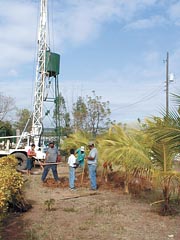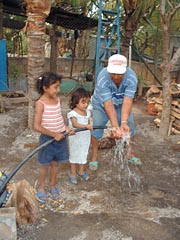
Moore, owner of Moore Drilling Co. of Bristow, Okla., and Tulsa Rotarian Bob Scroggs, supported by Bob's home club, local Rotarians in Nicaragua and many others, have been to Nicaragua twice in as many years. So far, they have drilled and completed 10 water wells for the poor residents living in the slums on the outskirts of towns and cities in western Nicaragua. Another drilling trip is planned for January and February of 2005. Moore and Scroggs will volunteer their time, efforts and skills for six weeks to eight weeks, and hope to drill at least 15 good wells on this trip. Although neither Scroggs nor Moore speaks Spanish, they are great favorites of the locals, who have dubbed Moore, “Tio Miguel” - “Uncle Mickey” in Spanish.
Scroggs, a retired engineer, who came to the country on a mission trip with his church, conceived the Nicaragua Water Well Project. Seeing the critical need for safe water among many residents of the second poorest country in the Western Hemisphere, Scroggs came home to his local Rotary club fired up with the idea of buying a water well drilling rig and returning to Nicaragua. He began searching for a suitable rig all around eastern Oklahoma and nearby west Arkansas and, as luck would have it, he met Moore in the process.
Moore, who has drilled water wells in eastern Oklahoma for 27 years, once went on a church-sponsored trip to West Africa. While there, he helped drill wells for a couple of orphanages, but he was not fully satisfied with the results. He was eager for another chance. Moore told Scroggs, “January and February are my slow time in Oklahoma. I'll help you find a rig that we can fix up, then we'll go drill 'em some wells.”
Scroggs and Moore located an old Port-A-Drill Model 501, S/N98, mounted on a 1976 Ford 21⁄2- ton carrier. It was in rough shape and had been out of service and stored out in the open for years, but it would run and it came with about 25 15-foot joints of 23⁄8-inch drill pipe. They hauled the rig over to Moore's shop in Bristow - about 40 miles west of Tulsa - and began renovation. After putting the rig in working order and drilling a couple of 250-foot to 300-foot test holes, the rig was stripped and repainted, the brakes were overhauled and a few other minor repairs were made. The rig was ready to roll.
The first drilling trip in January and February of 2003 was a learning experience. Research on the Internet had shown that the area all around Masaya and the old colonial capitol of Granada - indeed most of western Nicaragua - was composed of volcanic ash and rock. Although Tulsa is in the heart of oil well country, the project team could find no one with experience drilling in such material. The only indications were that the subsoils would likely be porous and abrasive. How true this turned out to be!
The first well swallowed water like dry desert sand. And with no way to secure drilling water themselves, Moore and his crew had to rely on locals to bring tankers of water to the drill site. In a country where water is a precious substance, the sight of 10,000 gallons of water being sucked down a well bore in 30 minutes was hard to justify to local officials. “There's got to be a better way,” Moore said.

Moore was convinced the compressed-air technique he used in Oklahoma formations would work in Nicaragua. He and Scroggs sold their supporters on the need, and then located an old unitized SulAir twin vane air compressor, driven by a 200 HP 6V71 Detroit Diesel. The unit could put out 750 cubic feet per minute at 150 psi. This would be the answer, Scroggs and Moore felt.
The team returned to Nicaragua in January of 2004 and was successful in drilling and completing nine good wells, at depths ranging from 170 to 285 feet. The wells were drilled with a 63⁄4 tri-cone tungsten carbide bit. They were cased with 41⁄2-inch PVC pipe and gravel-packed to the surface. The wells produce through 1-inch polypipe, and are equipped with 220-volt submersible pumps, ranging from 3⁄4 HP to 11⁄2 HP. They all are capable of producing at least 10 gpm and do not pump off.
Moore attributes much of his team's success to the help of a young driller from California named Josh Silva. Silva was an employee of Campbell Drilling of Ukiah, Calif. Ann Campbell, owner of Campbell Drilling, heard of the water well project and paid Silva's salary and expenses to let him come to Nicaragua for two weeks so that he could take part in the work. “Josh is a fine young man. He was a tremendous help to me,” says Moore.
Moore and Scroggs are looking forward to their next trip, which will be in January and February 2005. Plans are in place to drill 15 wells, and equipment now is being assembled for shipment. Do you wonder how the equipment and supplies get to Nicaragua? They are loaded into a 45-foot enclosed trailer and trucked to Gulfport, Miss., where the trailer is loaded as deck cargo aboard a vessel belonging to Crowley Marine Services. The trailer then is off-loaded in Puerto Cortes, Honduras, and pulled across the mountains to the Nicaraguan capitol of Managua for unloading. Nicaraguan Rotarians will then take charge of the cargo until Moore and his team can arrive.
Meanwhile, other Nicaraguan children wait and dream of the day they have access to clean safe water in their neighborhood.
ND
Report Abusive Comment